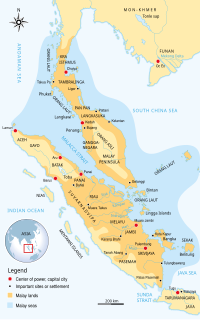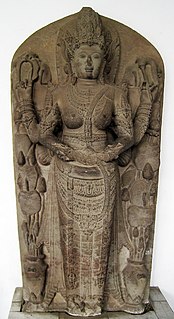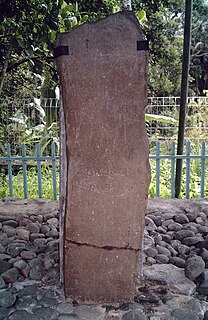Related Research Articles

Srivijaya was a Malay Buddhist thalassocratic empire based on the island of Sumatra, which influenced much of Southeast Asia. Srivijaya was an important centre for the expansion of Buddhism from the 7th to the 12th century AD. Srivijaya was the first unified kingdom to dominate much of the Malay Archipelago. The rise of the Srivijayan Empire was parallel to the end of the Malay sea-faring period. Due to its location, this once-powerful state developed complex technology utilizing maritime resources. In addition, its economy became progressively reliant on the booming trade in the region, thus transforming it into a prestige goods-based economy.

The Shailendra dynasty was the name of a notable Indianised dynasty that emerged in 8th-century Java, whose reign signified a cultural renaissance in the region. The Shailendras were active promoters of Mahayana Buddhism with the glimpses of Hinduism, and covered the Kedu Plain of Central Java with Buddhist monuments, one of which is the colossal stupa of Borobudur, now a UNESCO World Heritage Site.

The Mataram Kingdom was a Javanese Hindu–Buddhist kingdom that flourished between the 8th and 11th centuries. It was based in Central Java, and later in East Java. Established by King Sanjaya, the kingdom was ruled by the Shailendra dynasty and Ishana dynasty.

Adityawarman was a king of Malayapura Suvarnabhumi, and is the successor of the Mauli dynasty based on central Sumatra. He was the cousin of Jayanegara, king of Majapahit from 1309–1328, and the grandson of Tribhuwanaraja, king of Melayu Kingdom. Adityawarman was awarded the Senior Minister of Majapahit (wreddamantri) and used this authority to launch Majapahit military expansion plans and conquered east coast region in Sumatra. Adityawarman then founded the royal dynasty of Minangkabau in Pagaruyung and presided over the central Sumatra region to take control of the gold trade between 1347 and 1375.

The Melayu Kingdom was a classical Buddhist kingdom located in Southeast Asia.

The Pamalayu campaign was a diplomatic and military expeditionary force sent by Javanese King Kertanegara of Singhasari to conquer the Sumatran Melayu Kingdom. It was decreed in 1275, though perhaps not undertaken until later.

Tribhuwana Wijayatunggadewi, known in her regnal name Tribhuwannottunggadewi Jayawishnuwardhani, also known as Dyah Gitarja, was a Javanese queen regnant and the third Majapahit monarch, reigning from 1328 to 1350. She also bears the title Bhre Kahuripan. With the help of her prime minister Gajah Mada, she pursued a massive expansion of the empire. Tradition mentioned her as a woman of extraordinary valour, wisdom and intelligence.

Dharmasraya is the capital and also the name of the 11th century Buddhist kingdom based on the Batanghari river system in modern-day West Sumatra and Jambi, on the island of Sumatra, Indonesia. The kingdom itself could be identified by the name of its capital Dharmasraya or by the name Bhumi Malayu or Suvarnnabhumi according to Padang Roco Inscription. The reference to the name Malayu signify that the kingdom is located on previously older Malayu kingdom area prior being absorbed into Srivijayan mandala c. late 7th century, thus suggesting that Dharmasraya was the successor of Malayu. Dharmasraya became an independent kingdom after the downfall of Srivijaya in 1025.
Ananggawarman was a crown prince (yuvaraja) of the Malayapura kingdom, which ruled at the end of the 14th century. The Malayapura kingdom was centered on the Minangkabau Highlands and its territory covers much of central Sumatra. The name Ananggawarman is inscribed on Saruaso II inscription as the son of King Adityawarman. It is not clear when Ananggawarman began to reign in place of his father, but it was written in the History of Ming that the kingdom sent a messenger again to China in 1376.

The Padang Roco Inscription, in Indonesian Prasasti Padang Roco, is an inscription dated 1286 CE, discovered near the source of Batanghari river, Padangroco temple complex, Nagari Siguntur, Sitiung, Dharmasraya Regency, West Sumatra, Indonesia.
Dara Petak or Dara Pethak, also known in her formal name as Indreswari, was the consort of King Kertarajasa Jayawardhana, the founder of Majapahit kingdom. She was a Dharmasraya princess from Sumatra and the only non-Javanese wife of Kertarajasa, and also the mother of Jayanegara, the second monarch of Majapahit. Tradition mentioned her as a woman of exceptional beauty.
Dara Jingga, was one of the Malay Dharmasraya princess who was intended to be betrothed to Javanese King Kertanegara of Singasari after the Pamalayu expedition 1275–1293.
Isyana stylized as Sri Isyana Tunggawijaya was a queen regnant of Medang Kingdom, in East Java, that ruled since 947 CE. She co-reigned with her spouse, Sri Lokapala. The Isyana dynasty, established by her father, Mpu Sindok that ruled Java circa the 10th century CE, was named after her.

The Aru was a major Sumatran kingdom from the 13th to the 16th century. It was located on the eastern coast of North Sumatra, Indonesia. In its heyday the kingdom was a formidable maritime power, and was able to control the northern part of the Malacca strait.
Bijayendrawarman was the name of one a yuwaraja of the Malayapura kingdom, who ruled in the 14th century in the Pasaman Regency, West Sumatra, Indonesia. Bijayendrawarman's name is written in Lubuk Layang inscription, found in Pancahan village, in Rao Selatan district of Pasaman. It was stated that he built a stupa, in a place called Parwatapuri.
Akarendrawarman was a ruler of Malayapura kingdom in the Minangkabau plateau. His name was found in the Pagaruyung VII inscription, which is written in Old Malay, his full title is Paduka Sri Maharajadhiraja Srimat Sri Akarendrawarman. In carrying out his administration, he was assisted by various other officials, among others was a minister called Tuhan (lord) Parpatih. The kingdom was mentioned to be located in Parhyangan on Mount Mahameru.

Sri Maharaja Srimat Tribhuwanaraja Mauliwarmadewa was a king of Dharmasraya in Bhumi Malayu (Sumatra), as written on the Padang Roco inscription (1286). The inscription mentioned that the king and his people of Brahmin, Kshatriya, Vaishya, and Shudra classes all felt grateful to receive a gift of Paduka Amoghapasa statue from King Kertanagara, the king of Singhasari in Bhumi Java (Java).
Lubuk Layang inscription, also known as Kubu Sutan inscription, is an inscription found in 1970 in Kubu Sutan, Lubuk Layang, Rao Selatan district, Pasaman Regency, of West Sumatra, Indonesia.

Saruaso II inscription, also previously known as Batusangkar inscription, is one of the inscriptions from the King Adityawarman era. It is currently located at the Fort van der Capellen area, in the courtyard of the old office of the Monuments Preservation Department, in Batusangkar city, West Sumatra, Indonesia. The inscription was previously displayed across in front of the Indo Jalito Building, which was the residence of the Regent of Tanah Datar during the Dutch colonial period. The inscription is written in Old Javanese script and Sanskrit language.

Kuburajo Inscription, also called Kuburajo I Inscription, is one of the many inscriptions left by King Adityawarman of central Sumatra. The inscription was found in Kuburajo village, Lima Kaum district, Tanah Datar Regency, West Sumatra, Indonesia in 1877 besides the main road from Batusangkar city to Padang city. The inscription was registered by N.J. Krom in Inventaris der Oudheden in de Padangsche Bovenlanden. The inscription is written in Sanskrit, and consists of 16 lines. This inscription was lost in 1987, but was rediscovered.
References
- ↑ Kozok, Uli (2015). A 14th Century Malay Code of Laws: The Nitisarasamuccaya. Vol. 16. Institute of Southeast Asian Studies. p. 39. ISBN 9814459747.
- 1 2 3 4 5 6 7 Muljana, Slamet (2005). Runtuhnya kerajaan Hindu-Jawa dan timbulnya negara-negara Islam di Nusantara (in Indonesian) (reprint ed.). LKiS Pelangi Aksara. p. 8. ISBN 9798451163.
- 1 2 Kozok, Uli (2006). Kitab Undang-undang Tanjung Tanah: Naskah Melayu yang Tertua (in Indonesian). Yayasan Obor Indonesia. pp. 36–37. ISBN 9794616036.